Truth comes out of error more readily than out of confusion.
—Francis Bacon
What do successful athletes not blessed with Olympic genes have in common?—Patience to tweak their training, one variable at a time, until they have found “their” way.
Contrast that with a typical trainee who impatiently switches programs before he has had a chance to see whether they deliver. This fussbudget also complicates his training to the point where it is not possible to make any sense out of what works and what does not. Add an overwhelming amount of data incoming from all sorts of fancy gadgets, and he is totally lost.
This article will attempt to give you a structure for approaching your training like a champion—focused, methodical, non-excitable. It is based on the accepted procedures of designing a scientific experiment, simplified. You are not going to be conducting a true scientific experiment. It is neither realistic nor necessary to live up to that rigorous standard in your “courage corner.” But if you are right more often than you are not in drawing the correct conclusions from your log, very soon you will be well ahead of the pack.
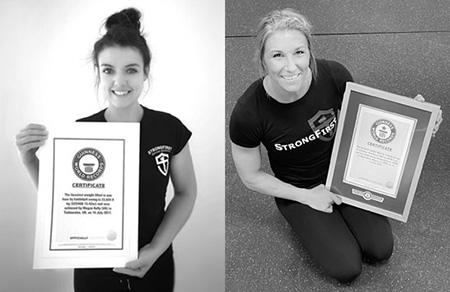
The Seven Steps to Strength
1) Set the goal of the experiment.
2) Review the existing solutions and select the most promising overall program design.
3) Select the variable to change or observe. Maximally reduce the number of other variables; make them constants.
4) Select one of the Mill’s Laws as an aid.
5) Write down a rigid game plan. Make no changes until the end of the experiment except in emergency.
6) Take detailed notes.
7) Conduct preliminary analysis during the experiment and the final analysis upon its completion.
1) Set the goal of the experiment.
State: “I shall complete the Sinister challenge.” Set a big audacious long-term goal and work back from it.
A medium-term goal is next. E.g., “achieve the Timeless standard with 40kg,” “win a state powerlifting title,” “military press the Beast”, “do ten strict tactical pullups,” or “go strong for three five-minute rounds.”
Once that is in place, you need a short-term plan, four to six weeks.
Your goals must be very specific; something along the lines of “I just want to get stronger” or “I want to lose a few pounds” is a recipe for failure.
E.g., you are training to become a Beast Tamer, so your long-term goal is to put up a 48kg kettlebell in the one-arm military press, the tactical pullup, and the pistol. Currently you can strongly press 36kg once. A realistic six-week goal would be pressing the same kettlebell for five singles.
Advanced athletes know to moderate their expectations.
Beginners should set ambitious goals—but they have no need to be conducting science experiments. Keep your life simple and follow a proven foolproof program like Kettlebell Simple & Sinister.
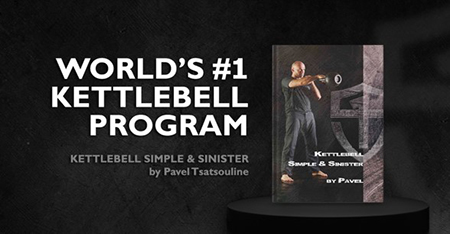
BOOK (Paperback, Kindle, or Audio) or VIDEO
If your sport or occupation does not allow the luxury of narrow specialization, you should not try to improve everything across the board at once but rather focus on one or two goals while maintaining your performance in the other events. For instance, a SWAT officer may want to focus on his Secret Service kettlebell snatch test for three months and for the next three emphasize his weighted pullups.
Fortunately, it takes a lot less work to maintain the chosen quality, lift, etc. at a given level than to improve it. For instance, Soviet researchers determined that a male military recruit could reach fifteen strict pullups with a weekly volume of 60-100 total reps and maintain this decent level with only 40-60.
This phenomenon of easy maintenance will enable you to sequentially focus on different goals serving the master goal and significantly reduce your training time while making great gains.
2) Review the existing solutions and select the most promising overall program design.



3) Select the variable to change or observe. Maximally reduce the number of other variables; make them constant.
Follow the analytical process of Steve Baccari. This coach extraordinaire selects an exercise to act as a marker. For instance, he knows that if he practices kettlebell military presses regularly, he can put up the 88-pounder. Steve quits MPs for a few weeks and does a new exercise—just one—instead. Then he tries to press the “Bulldog” again. If his pressing strength is at least the same as before, the coach concludes that the new drill is a winner.
Why is maintaining good?—Because not losing ground without specific practice always translates into a personal best when you resume it. As soon as you have revisited the target lift a couple of times, you will get your groove back and set a PR. If you are not peaking for a competition, a “Westside peak,” or working up to your max once a week three weeks in a row, will do the job without complicating things.
In another cycle, Baccari tested the kettlebell bent press and found out that he did not lose any of his military pressing strength. Steve marked the BtP as a keeper; after all, not only did it improve the MP, it also stretched and stabilized the shoulder and worked the lat.
In a different experiment the coach evaluated the bent press against the windmill. He concluded that the latter was just as good for working the side and hip muscles as the former. Thus, why do three exercises if one can do it all?
To sum up, play with one variable while trying to keep everything else equal and as simple as possible.
4) Select one of the Mill’s Laws as an aid.
The logician’s tool you will be using to get yourself stronger through observation is induction. This big word means pattern recognition and inference based on limited data.
Induction is a generalization and as such it could be wrong, but it is okay. You do not have to get it right every time. More than 50% will put you ahead of the pack. The five inductive techniques are known as the Mill’s Laws. They will help you on your strength and self-improvement quest.
Method of Agreement
Whenever there is A, there is B. A appears to cause B.
For example, “Every time I upped the volume of my presses, I got stronger. High tonnage appears to improve my pressing power.”
Note that the method of agreement will do you no good if you make more than one change in your training at once. Perhaps every time you have upped your pressing volume, you also started taking a creatine supplement. Was it the volume, the creatine, or their combination that worked?
Method of Difference
If A is not present, B goes away. A appears to cause B.
For example, “Every time I reduce my pressing volume, my strength goes down. Hence, I need high volume to be a strong presser.”
Watch out for eliminating something else along with the volume drop. For instance, if you also cut back on intensity, how do you know the drop in which load parameter was responsible for the strength loss? Volume, intensity, or both? This should make it obvious that you will not optimize your strength training until you stop messing around with more than one variable at a time.
Joint Method of Agreement and Difference
Whenever there is A, there is B. When A is not there, neither is B. A appears to cause B.
For example, “Every time I reduce my pressing volume, my strength goes down. Every time I increase the volume, my strength goes up. High volume is needed to get stronger at presses.”
A combination of the first two methods, the joint method of agreement and difference is obviously more powerful than either of its two components.
Method of Residues
All variables but A are eliminated as possible causes of B. A appears to cause B.
For example, “My knees are sore after yesterday’s training. I know it is not the snatches. Front squats have never bothered me before either. The only suspect left is the jerk. It has to be the jerks.”
This one is easier to understand if we call it “the method of elimination.” If a murder took place in a snowed-in mansion and everyone but the butler was accounted for at the time of the murder, the butler must be the killer. The murder mystery approach comes in handy in analyzing the effects of complex training programs.
Method of Concomitant Variation
If A changes, B changes correspondingly.
For example, “Whenever I add three reps to my front squat with a pair of 32s, I add two reps to my jerk with the same kettlebells. Front squats appear to improve my jerk.”
Soviet strength scientists coined a term, the “transfer ratio,” that helps evaluate the effectiveness of an assistance exercise. Here is the formula:
Transfer = gain in the target lift/gain in the special exercise
In repetition kettlebell lifting the gain is easiest to measure with reps. In the above example of front squats and jerks, the transfer is 2/3 or 0.66.
In a separate cycle you should experiment with another leg exercise, for instance, the reverse lunge with a pair of kettlebells in the rack. Say you have found out that the ratio is 1/2 and the transfer is 0.5. Obviously, front squats are better.
But beware of judging exercises by the transfer ratio alone. The relative difficulty of making gains in a given drill is a factor. For instance, if you test the pistol with a 32kg kettlebell, you might find out that every rep you add to this killer boosts your jerks by awesome four reps. The transfer ratio is a spectacular 4/1=4. But does this mean that the pistol is far superior to the front squat?—No, because it might be easier to add six reps to the 2*32kg front squats than to add a single rep to pistols with 32kg.
Calculating the transfer ratio will enable you to find your most effective assistance exercises. It does not mean that you should not do other drills; only that you should save the best for when it counts the most. A standard procedure for many Soviet strength athletes was to lay off their most effective exercises for a while to make their bodies extra responsive to them, then pull out the big guns in the cycle building up to a very important event such as the Olympics.
5) Write down a rigid game plan. Make no changes until the end of the experiment except in emergency.
This should be obvious. Jumping around from one exercise to another or switching routines as often as socks is a dead end. Have the patience to see your “strength science experiment” through. Quitting because you “feel” that whatever you are doing is not working is an emotional approach to training and it will fail as such.
6) Take detailed notes.
And save them. Years down the road, you will be able to mine gold from your training journals. There is a line in a song by Mouslim Magomayev, a Soviet singer of my parents’ generation: “My memories are my judges and my mentors.” I doubt “Soviet Sinatra” had learning strength lessons from your training log in mind, but it sure works for us.
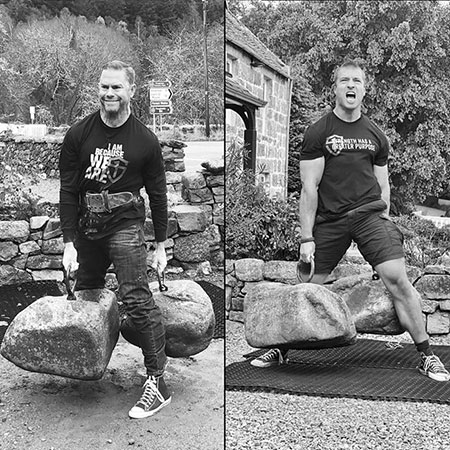
lifting the legendary Dinnie Stones.
Accomplishing a feat like that takes not only toughness
but a scientific mindset.
7) Conduct preliminary analysis during the experiment and the final analysis upon the completion.
“It is hard to imagine anything that would retard long-term progress more than the failure to learn from experience,” wrote Arthur Drechsler whose Weightlifting Encyclopedia has inspired this article.
I will leave you with a call to view your training as evolution, not revolution.
What is a “revolution”?—A violent overthrow of an existing order in favor of another, a radically new one. Just say “1776.”
“Evolution,” in contrast, is a gradual, barely noticeable development. It is not nearly as exciting, but at least as important for getting places over a long haul. In two centuries, the U.S. of A. have evolved into the most awesome place for a working person to live. While it would not have happened without the American Revolution, more revolutions would have ruined this great country. Third world countries with weekly coups are a case in point.
You have made a revolution by accepting StrongFirst training methods. Now it is time to let your training evolve slowly.
Patience and power to you!



# # #
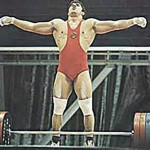
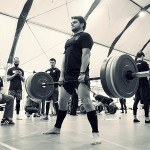
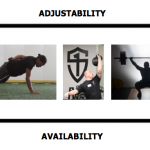
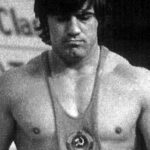

Always great to see an article from Pavel. I was just talking to a coach at work today about how I am still unpacking ideas from the Programming Improv last spring. The wisdom is much appreciated!
Interesting and challenging thoughts, Pavel! Let me share my latest observations regarding some of your claims and plans:
After reaching Timeless Simple I have set myself the goal of achieving a half body MP (which will probably take a me a few years) while maintaining or building my “Strong Endurance”.
For 8 months I followed experimental ROP 2.0 (handed to me by an SFG) and made good progress.
Since then I have been rotating two-week blocks of ROP 2.0 with KBSF Plan A (LCCJ) as a kind of A+A single bell ROTK. Currently, I am in month 5 of my experiment.
This time around my C&P progress has been much better (if counting the number of sessions or weeks for moving up to more difficult ladders and volume). The first two sessions of each block feel a bit heavier than I would like but I will always leap ahead naturally during the second week. (I always start with a medium week, followed by a heavier week: MHM, HMH.) My LCCJ progress has also been great for four blocks – until I hit a wall with CJCJC during my current block.
This experiment confirms your claims in ROTK about block training and two week blocks. (However, I have also reduced my swings and snatches somewhat during pressing blocks.)
I have also experimented with “postconditioning hormesis” and have found it to work perfectly, as described in the newsletter. Another experiment has been to add a very light technique session prior to starting the next block (on Saturdays). So far it looks like this might help with easing into the next block, but I need more cycles to come to a stronger conclusion.
Anyway, thanks again for all of your work and have a great year.
Bauer, thank you for your kind words and your feedback!
How much pressing strength did you gain on the ROP? I doubt you need years to press 1/2 BW with one arm.
I went from 16 to 20 kg in my first cycle. Now I have progressed to 3×5 ladders with the 20 kg in 10 weeks of pressing with my former 4TRM bell.
For reference: I am 194 cm( 6’4”) tall, weigh 80 kg, have long arms, and pressing has always been my weakness.
This is the first pressing plan that does not bother my elbows or shoulders.
Bauer, my recommendation would be to add muscle all over—unless there are some athletic reasons not to—and then focus on pressing.
Are you experienced with double kettlebell exercises or barbell lifts?
Thank you, Pavel.
No, I only have single KBs (in 4kg increments from 12 to 40 kg) at home, but would be willing to purchase a few matching bells for doubles. I believe my shoulder mobility should be good enough for work with doubles by now (TGUs, arm bars and Brettzels have helped a lot).
My original idea was to work up to 32 kg in single bell lifts (C&P, LCCJ) and building organic muscle along the way before moving to doubles.
If you have any recommendation for a protocol or a starting point, I would be grateful.
I have purchased a lot of plans and protocols from the SF world – mostly authored by you, Fabio Zonin, Brett Jones, and also by Geoff Neupert. (I must say that I enjoy the block training method with ROP 2.0 and KBSF a lot.)
PS: I have checked my notes and found your comment under your latest A+A article on using Double LCCJ for hypertrophy, alternating KBSF and Glycolytic power repeat cycles. If that is your recommendation for me as well, I wonder which cycle length would be advisable. And would pressing maintenance be a good idea? But, of course, I am open to other suggestions as well and would appreciate your guidance.
Bauer, now that I know your circumstances, I suggest that you focus on building your muscle mass with double kettlebells and deprioritize everything else.
Double front squats, cleans, presses. Programming options include “the Moving Target Complex,” “Fast 10s,” and Geoff Neupert’s doubles’ programs.
Dear Pavel, thank you so much for your guidance! I will order matching bells, and — depending on my schedule limitations and my actual RMs — start Easy Muscle (Geoff Neupert) or BuiltStrong Minimalist (Fabio Zonin) when they arrive.
Looking forward to your upcoming books!
Wow, Pavel… so much to contemplate here.
For the new year, I’m restarting to Q&D protocol after working through your one clean, one jerk on the minute and half minute… got up to the three each for 30 minutes and was amazed at the change to my body with such an abbreviated program.
The dice roll in the Q&D system means multiple variables: reps, sets, 1 or 2 arm swings, etc, so that goes against some of the points of this article, but I will do the program as written and will bookmark this article for my next cycle of pure strength training.
Thank you for your kind words, Albert!
What were the exact improvements that you made on the A+A C&J program?
In Q&D SF has done the experimentation for you, one variable at a time.
It’s hard to he objective when judging your body, but I kept being startled with the vascularity in my arms and shoulders in the mirror after a shower. I’m not a guy that poses for vanity sake, but the veins popping out were new to me, even the forearms looked like a medic could insert an IV without a constrictor tie.
I also lost 8 or 9 pounds while getting stronger… win, win
I did the program exactly as you presented it, Monday and Thursday, working up to 30 minutes passing the talk test, then adding a clean, then another jerk, getting up to 3 C&J for 30 minutes. I kept thinking, “is this enough?”… yes it is!
Cool, Albert!